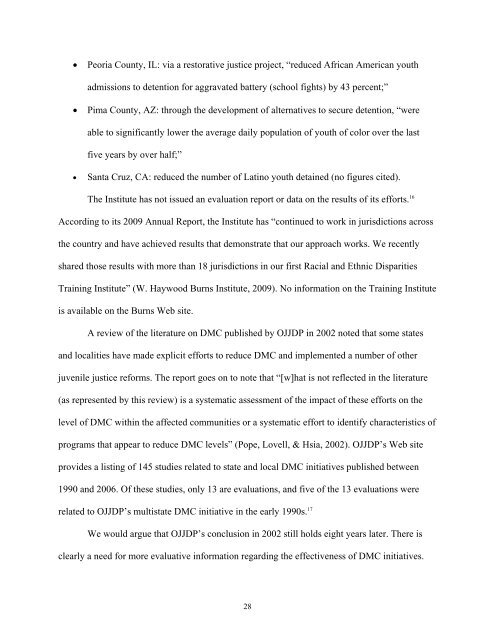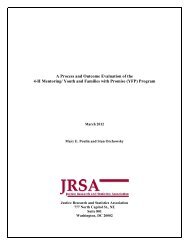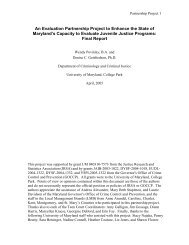A Review of the Status of DMC Efforts in Iowa and Virginia - April 2010
A Review of the Status of DMC Efforts in Iowa and Virginia - April 2010
A Review of the Status of DMC Efforts in Iowa and Virginia - April 2010
You also want an ePaper? Increase the reach of your titles
YUMPU automatically turns print PDFs into web optimized ePapers that Google loves.
• Peoria County, IL: via a restorative justice project, “reduced African American youth<br />
admissions to detention for aggravated battery (school fights) by 43 percent;”<br />
• Pima County, AZ: through <strong>the</strong> development <strong>of</strong> alternatives to secure detention, “were<br />
able to significantly lower <strong>the</strong> average daily population <strong>of</strong> youth <strong>of</strong> color over <strong>the</strong> last<br />
five years by over half;”<br />
• Santa Cruz, CA: reduced <strong>the</strong> number <strong>of</strong> Lat<strong>in</strong>o youth deta<strong>in</strong>ed (no figures cited).<br />
The Institute has not issued an evaluation report or data on <strong>the</strong> results <strong>of</strong> its efforts. 16<br />
Accord<strong>in</strong>g to its 2009 Annual Report, <strong>the</strong> Institute has “cont<strong>in</strong>ued to work <strong>in</strong> jurisdictions across<br />
<strong>the</strong> country <strong>and</strong> have achieved results that demonstrate that our approach works. We recently<br />
shared those results with more than 18 jurisdictions <strong>in</strong> our first Racial <strong>and</strong> Ethnic Disparities<br />
Tra<strong>in</strong><strong>in</strong>g Institute” (W. Haywood Burns Institute, 2009). No <strong>in</strong>formation on <strong>the</strong> Tra<strong>in</strong><strong>in</strong>g Institute<br />
is available on <strong>the</strong> Burns Web site.<br />
A review <strong>of</strong> <strong>the</strong> literature on <strong>DMC</strong> published by OJJDP <strong>in</strong> 2002 noted that some states<br />
<strong>and</strong> localities have made explicit efforts to reduce <strong>DMC</strong> <strong>and</strong> implemented a number <strong>of</strong> o<strong>the</strong>r<br />
juvenile justice reforms. The report goes on to note that “[w]hat is not reflected <strong>in</strong> <strong>the</strong> literature<br />
(as represented by this review) is a systematic assessment <strong>of</strong> <strong>the</strong> impact <strong>of</strong> <strong>the</strong>se efforts on <strong>the</strong><br />
level <strong>of</strong> <strong>DMC</strong> with<strong>in</strong> <strong>the</strong> affected communities or a systematic effort to identify characteristics <strong>of</strong><br />
programs that appear to reduce <strong>DMC</strong> levels” (Pope, Lovell, & Hsia, 2002). OJJDP’s Web site<br />
provides a list<strong>in</strong>g <strong>of</strong> 145 studies related to state <strong>and</strong> local <strong>DMC</strong> <strong>in</strong>itiatives published between<br />
1990 <strong>and</strong> 2006. Of <strong>the</strong>se studies, only 13 are evaluations, <strong>and</strong> five <strong>of</strong> <strong>the</strong> 13 evaluations were<br />
related to OJJDP’s multistate <strong>DMC</strong> <strong>in</strong>itiative <strong>in</strong> <strong>the</strong> early 1990s. 17<br />
We would argue that OJJDP’s conclusion <strong>in</strong> 2002 still holds eight years later. There is<br />
clearly a need for more evaluative <strong>in</strong>formation regard<strong>in</strong>g <strong>the</strong> effectiveness <strong>of</strong> <strong>DMC</strong> <strong>in</strong>itiatives.<br />
28
















